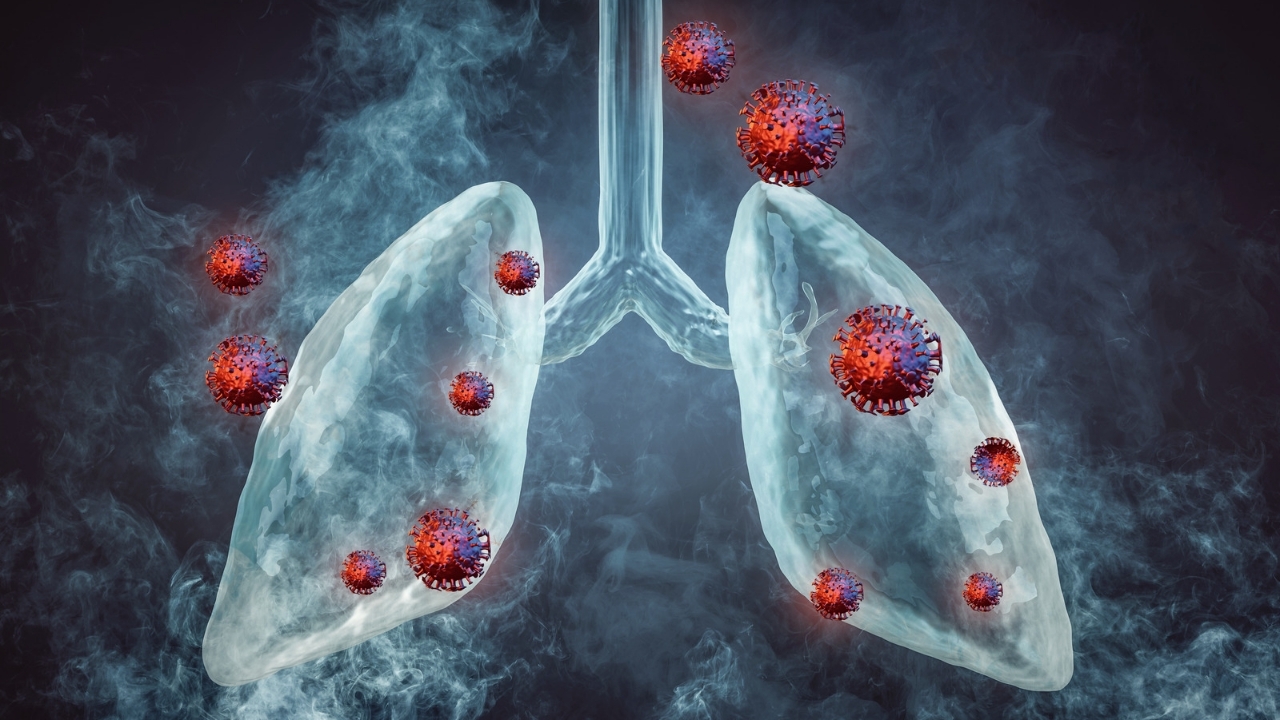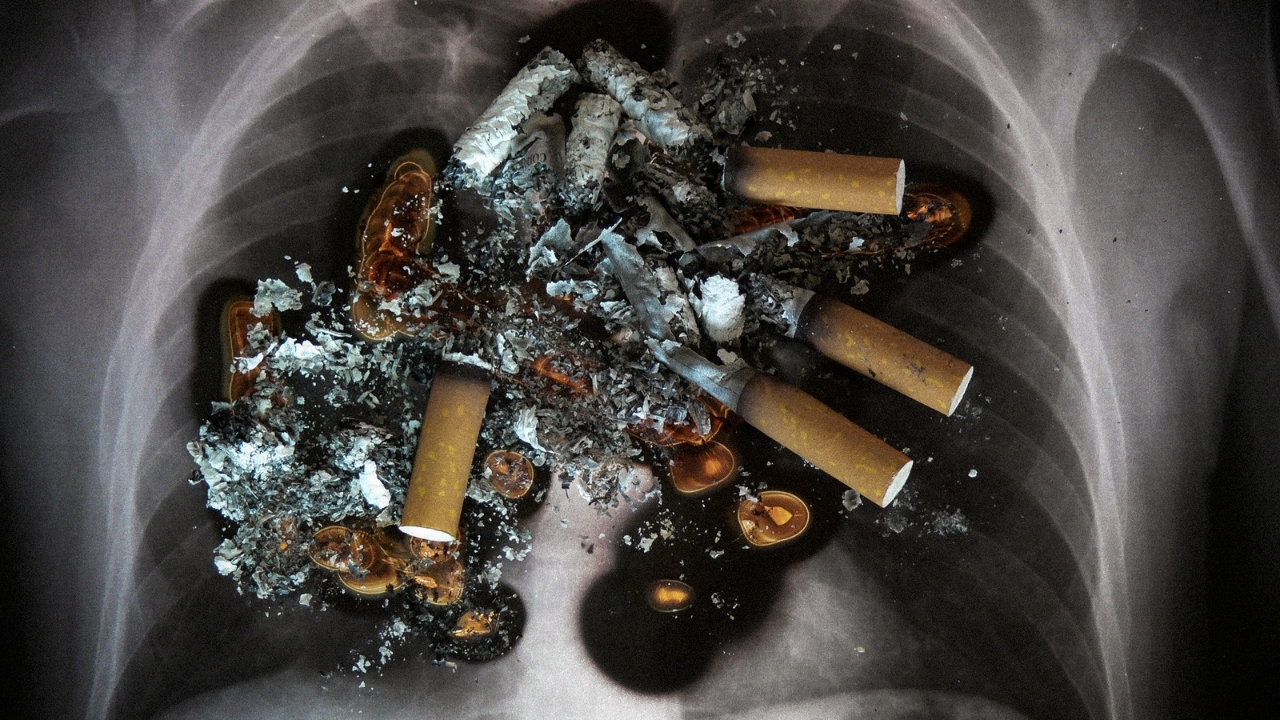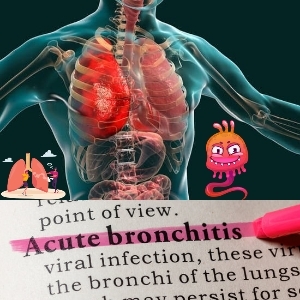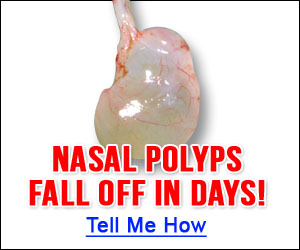Do you ever feel short of breath, cough uncontrollably, and experience fatigue when doing simple tasks? If so, it’s possible that you’re experiencing Chronic Bronchitis. This type of lung disease is often known as the “Blue Bloater” due to its association with cyanosis (bluish discoloration of the skin) and weight gain.
But what exactly is Chronic Bronchitis?
How does it differ from Asthma?
And most importantly, what can be done to manage this condition?
In Todays Article we will discuss the characteristics of chronic bronchitis blue bloaters and how they can be managed. So let’s explore this Chronic Bronchitis which is a common respiratory disorder!

As a result of inflammation and narrowing of the airways leading to the lungs, Chronic Bronchitis is a type of chronic obstructive pulmonary disease (COPD). Chronic Bronchitis Blue bloaters have a distinct appearance and clinical characteristics that distinguish them from other patients.
The coexistence of Chronic Bronchitis blue bloater with other comorbidities such as obesity, diabetes, and cardiovascular disease is an important aspect of chronic bronchitis blue bloater. As a result, Chronic Bronchitis blue bloater requires a multidisciplinary approach that addresses the underlying comorbidities in order to manage the condition effectively.
A second aspect to consider is the impact of environmental factors on the progression of the disease. The condition can be worsened and aggravated by exposure to air pollution, occupational hazards, and other environmental toxins. The risk of complications can be minimized by identifying and avoiding these triggers.
Patients with chronic bronchitis blue bloater can also benefit from lifestyle modifications in addition to pharmacological and non-pharmacological treatments. It is possible to improve lung function, reduce inflammation, and prevent exacerbations by quitting smoking, exercising, and following a healthy diet.
Finally, early diagnosis and treatment of Chronic Bronchitis blue bloater are crucial in preventing disease progression and improving quality of life. Therefore, it is essential to seek medical attention if you experience symptoms such as chronic cough, shortness of breath, and fatigue.
What is Chronic Bronchitis Blue Bloater?
Chronic Bronchitis is a medical condition that leads to the inflammation and narrowing of the airways toward the lungs. The inflammation triggers the production of extra mucus, which can additionally obstruct the airways and make breathing complex.
Those affected by Chronic Bronchitis who present with a distinct appearance and clinical characteristics are referred to as Blue-bloaters. This name derives from their skin tone, due to decreased oxygen in their bloodstream caused by impaired lung function.
What are the Clinical Features of Chronic Bronchitis Blue Bloater?
The chronic bronchitis blue bloater has a distinct set of clinical features that differentiates it from other types of COPD patients. These features include:
Cyanosis: A bluish tint to the skin due to the lack of oxygen in the blood.
Edema: Swelling of the legs and feet due to fluid accumulation.
Chronic cough: A persistent cough that produces mucus.
Shortness of Breath: Difficulty breathing, especially with physical activity.
Fatigue: Feeling tired or exhausted.
Pulmonary Hypertension: High blood pressure in the lungs, which can lead to Heart failure.
What Causes Chronic Bronchitis Blue Bloater?
Inflammation and damage to the airways are caused by these irritants, which lead to excess mucus production, narrowing of the airways, and impaired lung function,
which are the causes of chronic bronchitis blue bloater.
In contrast to other types of COPD patients, those with chronic bronchitis blue bloater have more severe disease and more frequent exacerbations.
What is the treatment for Chronic Bronchitis Blue Bloater?
It is important to manage chronic bronchitis blue bloater symptoms and prevent exacerbations. Treatment options include:
Bronchodilators:
Medications that relax the airway muscles, allow for easier breathing.
Inhaled steroids:
Medications that reduce inflammation in the airways, preventing exacerbations.
Oxygen therapy:
Supplemental oxygen to improve oxygenation in the blood.
Pulmonary rehabilitation:
A program of exercise, education, and breathing techniques to improve lung function and quality of life.
Vaccinations:
Influenza and pneumococcal vaccines prevent respiratory infections that can trigger exacerbations.
https://todaysarticleshow.com/psychology-facts/
Simple Chronic Bronchitis vs Chronic Bronchitis:
COPD, or chronic obstructive pulmonary disease, is characterized by inflammation of the bronchial tubes, which causes coughing and difficulty breathing.
The more severe form of chronic bronchitis is chronic bronchitis, whereas the less severe form is simple chronic bronchitis. Chronic bronchitis can be debilitating and cause significant respiratory distress in both cases.
A number of treatments are used to treat chronic bronchitis, including inhalation therapy, oxygen therapy, and sometimes steroids.
Inflammation and narrowing of the bronchial tubes cause Chronic Bronchitis, which results in difficulty breathing, coughing, and mucus production. Simple chronic bronchitis does not involve mucus production.
Experiencing pollutants and irritants, such as cigarette smoke, can aggravate both types of chronic bronchitis.
Typically, chronic bronchitis is treated by avoiding irritants, quitting smoking, and taking medication to open the airways. In severe cases, hospitalization may be necessary.
Does Chronic Bronchitis Cause Shortness of Breath:
The condition Chronic Bronchitis affects the lungs and can often cause shortness of breath. Symptoms include difficulty breathing, wheezing, and coughing. It is caused by inflammation of the airways, which narrows them and makes it difficult for air to pass through.
The most common cause of chronic bronchitis is smoking, but it can also be caused by pollution or other irritants. Treatment includes avoiding triggers, taking medication to open up the airways, and using oxygen.
It is important to see your doctor regularly if you have chronic bronchitis in order to monitor and treat your condition effectively. Hospitalization may be necessary in severe cases.
>>>Advertisement:
Nasal Polyps: An Overview
Nasal polyps are abnormal growths that occur inside the nasal passages and the sinuses (canals found behind the cheekbones).
Nasal polyps can range from unnoticeable to large lumps, and sometimes they can hang outside the nose. They can be pink but also yellow or grey in color. They are soft and often described as jelly-like.
Symptoms of Nasal polyps:
Nasal polyps tend to be unnoticeable at first, being dismissed as the irritation associated with a common cold. Some early symptoms include itchiness in your throat and your nose becoming stuffy or occasionally clogged up.
These symptoms can increase and are often followed by your nose running a lot, unexplained bleeding and your nostrils becoming clogged completely. In some cases, if these growths are deep enough in your nose they block the airways at the back of your nasal cavity completely. When nasal polyps get big enough, they are easily visible from the outside.
Nasal polyps can cause you to have difficulty breathing. Loss of sleep can result and snoring is a less common symptom, but also occurs if the mucus growths partly obstruct the airways. You will also find you are more tired and have difficulty concentrating.
This is attributed to poor intake of air. You will often compensate by breathing through your mouth, which will cause you to be more susceptible to colds and upper airway infections. This is a result of the fact that you cannot filter the air you breathe through your nose.
In short, symptoms include:
Nasal congestion,
Anosmia (loss of sense of smell),
Sinusitis,
Secondary infection can lead to headaches,
Snoring may occur while sleeping,
Facial changes are not common, but are can occur,
Nose bleeds,
Coryza,
Cause of Nasal Polyps:
The exact cause for nasal polyps is unknown; however, they are commonly thought to be caused by:
Asthma,
Cystic fibrosis,
Exposure to some forms of chromium.
There are a few illnesses that can be associated with nasal polyp formation:
Asthma,
Chronic rhinosinusitis,
Aspirin intolerance,
Kartagener’s syndrome,
Young’s syndrome,
Churg-Strauss syndrome,
Nasal Mastocytosis,
Cystic fibrosis.
Manuel Richards is a certified nutritionist, biomedical researcher, and holistic health consultant. He is the author of Nasal Polyps Treatment Miracle, the only natural, holistic, and permanent cure for nasal polyps.
Symptoms of severe Chronic Bronchitis :
The main symptom of Chronic Bronchitis is a persistent cough that produces mucus (phlegm). Chronic bronchitis is usually caused by smoking, but it can also be caused by secondhand smoke, dust, fumes, or other irritants.
Medications are usually used to clear the airways and prevent infection, along with lifestyle changes, as part of chronic bronchitis treatment. Surgery may also be necessary in some cases.
Symptoms of Chronic Bronchitis include:
- A persistent cough that produces mucus (phlegm).
- Shortness of breath.
- Wheezing.
- Chest pain or tightness.
- A feeling of fatigue or exhaustion.
Acute exacerbations of chronic bronchitis occur when symptoms suddenly worsen during periods of physical activity or cold weather.
Acute exacerbations are often triggered by infection or exposure to environmental triggers (such as cold weather).
The Role of Exercise, Diet, and Smoking Cessation in Chronic Bronchitis Blue Bloater:
Chronic bronchitis is a form of COPD that is characterized by inflamed and irritated airways. The inflammation is caused by the overproduction of mucus, which can lead to difficulty breathing.
While there is no cure for chronic bronchitis, there are treatments that can help improve symptoms and prevent further damage to the lungs.
Exercise:
Exercise is important for people with chronic bronchitis as it can help improve lung function and respiratory muscle strength. It is important to start slowly and gradually increase the intensity as your tolerance allows. A pulmonary rehabilitation program may be recommended by your doctor.
Diet:
Eating a healthy diet rich in fruits, vegetables, and whole grains can help reduce inflammation throughout the body, including the lungs. Additionally, avoiding processed foods, saturated fats, and refined sugars will help decrease mucus production.
Smoking Cessation:
Smoking is the leading cause of chronic bronchitis, so quitting is essential for managing the condition. There are many resources available to help you quit smoking, including nicotine replacement therapies and counseling.
Best Humidifier for Chronic Bronchitis
Are you or someone you love suffering from Chronic Bronchitis?
Coughing, wheezing, and breathing problems can all be brought on by this chronic respiratory illness. For anyone coping with it, it can be a stressful and difficult experience.
Fortunately, there are approaches to controlling the effects of chronic bronchitis and raising your standard of living.
One effective solution is using a Humidifier. In Todays Article, we will explore the best humidifiers for chronic bronchitis and how they can help relieve your symptoms.
Can Humidifiers help relieve symptoms of Chronic Bronchitis?
The answer is yes!
Humidifiers work by adding moisture to the air, which can help alleviate dry coughs and congestion that often accompany Chronic Bronchitis.
Dry air can irritate the lining of your airways and make it harder to breathe, especially during cold winter months when heating systems tend to dry out indoor air even more.
You could get some relief from symptoms like coughing, wheezing, and shortness of breath by raising the humidity levels in your house.
Additionally, humidifiers can also help soothe sore throats and reduce sinus pressure caused by chronic bronchitis.
However, it is important to use a humidifier properly to avoid any potential negative effects. Overusing a humidifier or failing to clean it regularly can lead to excessive moisture build-up or the growth of bacteria or mold in your home.
You should choose a cool mist humidifier rather than a warm mist for those with chronic bronchitis since warmer temperatures could cause irritation in some people.
It’s also essential that you keep your device clean constantly using distilled water if possible since tap water has minerals that promote bacterial growth leading thus making things worse instead of better.
Using a high-quality humidifier is an effective way for managing various symptoms related to Chronic Bronchitis without going through complex treatments every time there’s an issue
What are the different types of Humidifiers?
Humidifiers can be an effective way to combat the symptoms of Chronic Bronchitis. There are several distinct types of humidifiers on the market, each with special characteristics and advantages.
Firstly, there are Cool mist Humidifiers that emit a cool mist into the air using ultrasonic vibrations. These tend to be quieter than other types of humidifiers and use less energy as they don’t require heat.
Warm mist Humidifiers, on the other hand, use a heating element to boil water before releasing it as steam. This type of humidifier is great for cold weather as it adds warmth to the air.
Next up is Evaporative Humidifiers that work by blowing air through a wet wick filter or belt. They tend to be more affordable but require regular cleaning to prevent mold growth in the filter/belt. There are whole-house or console units that can provide humidity throughout your entire home.
When choosing a type of humidifier for Chronic Bronchitis, consider factors such as noise level, ease of maintenance, and size/capacity needed for your space.
Advertisement…
Herbal Remedies for Asthma: Breathe Easy, Naturally!
Hey there, wheezers and breathless buddies! If you’re one of the many asthma sufferers out there, you know the drill: inhalers on standby and daily doses of meds.
But what if I told you there’s a way to tackle asthma without those pesky side effects? Oh yeah, we’re talking about natural remedies, baby!
Picture this: living your life without the chemical overload, and still keeping asthma in check. Sounds like a dream, right? Well, hold on to your hats, because I’ve got some herbal magic up my sleeve!
Introducing Herb Combo #1: The Middle Eastern Miracle Mix!
Take a trip to the aromatic oasis of the Middle East, and you’ll find a secret blend of chamomile, cinnamon, sage, black cumin seeds, cloves, rosemary, spearmint, thyme, and a bunch of other amazing herbs. People in these parts have been using this concoction for ages to tame that wild asthma dragon.
But wait, there’s more!
Not satisfied with just one remedy? No worries! Let’s jet off to the enchanting lands of Asia for…
Herb Combo #2: The Saiboku-To Sensation!
Picture yourself wandering through mystical Asian gardens, and there it is – the legendary mix containing ginger, magnolia, Baikal skullcap, licorice, and Korean ginseng. It’s like a party of powerful plants ready to kick asthma to the curb!
So, why should you try these Herbal wonders?
Well, my wheezy friend, it’s simple – they’re 100% Natural and don’t come with those nasty side effects you dread. No more wondering if your meds are doing more harm than good. It’s time to embrace the magic of mother nature!
Now, I know what you’re thinking – are these herbs really gonna work? Or am I just huffing and puffing at some fairy tale?” Fair question, my friend. These herbal remedies have been tried and tested by folks from ancient times to now.
Many asthma warriors have reported serious improvements in their conditions, and some even found themselves waving goodbye to their steroidal meds!
But remember, folks, no two wheezers are the same.
What works wonders for one might not do the same for another. So, it’s a bit of trial and error, just like finding that perfect pair of shoes that won’t give you blisters! Give these herbal mixes a shot, and see which one dances best with your lungs.
Now, before you run to the nearest Herb shop…
Remember to keep your doc in the loop! They’re the experts, after all. Share your herbal adventures with them, and let them guide you on this wheeze-free journey.
So, there you have it, asthma amigos! Herbal remedies that bring hope and relief without the pesky side effects. It’s time to kick asthma’s butt and breathe easy the natural way. Give those herbs a chance, and who knows, you might just find yourself having a lung party like never before!
>>> CLICK HERE to Join “Asthma Relief Forever” today and start breathing freely. Unlock a world of Asthma relief you never knew existed.
Breathe easy, breathe naturally – with “Asthma Relief Forever.”
Stay wheezy-free and keep those herbs close. Until next time, happy breathing, my asthma warriors!
How to Choose the Best Humidifier for Chronic Bronchitis?
It might be challenging to choose the finest humidifier for chronic bronchitis, especially if you are not familiar with the many models on the market.
Here are some things to consider when selecting the Best Humidifier for Chronic Bronchitis:
1. Type of Humidifier –
There are two main types of humidifiers: cool mist and warm mist. Cool mist models use ultrasonic technology or evaporation to produce moisture while warm mist ones boil water to create steam.
2. Room Size –
Consider the size of your room before buying a humidifier as it will determine how much moisture is needed to maintain an ideal humidity level.
3. Noise Level –
Some models may generate noise during operation, so make sure to check this aspect before purchasing.
4. Maintenance Requirements –
All humidifiers require maintenance such as regular cleaning and filter replacement, so choose a unit that suits your lifestyle.
5. Additional Features –
Look for additional features like auto shut-off, adjustable humidity levels, and timer settings that can improve convenience and ease of use.
By considering these factors, you’ll be able to select the best humidifier for your specific needs, helping you alleviate symptoms associated with chronic bronchitis such as coughing and wheezing caused by dry air in your home environment.
Chronic Bronchitis vs Asthma:
The difference between Chronic Bronchitis and asthma is that Chronic Bronchitis is a long-term inflammation of the bronchial tubes, while Asthma is a chronic lung condition that causes wheezing, chest tightness, and shortness of breath.
Asthma can be triggered by allergies, cold weather, exercise, or other environmental factors. Environmental triggers for chronic bronchitis are usually irritants such as tobacco smoke, dust, and fumes.
People with chronic bronchitis often have a productive cough that brings up mucus.
While there is not currently a cure for either chronic bronchitis or asthma, both conditions can be managed with medication and lifestyle changes.
For people with Chronic Bronchitis, quitting smoking is the most important thing you can do to improve your lung health. Avoiding other respiratory irritants, staying hydrated, and getting regular exercise can also help manage symptoms.
There are two main types of Asthma medications:
Long-term control medications and Quick-relief medications.
Long-term control medications are taken daily to prevent asthma attacks from happening.
Quick-relief medications are used to relieve symptoms during an asthma attack. Asthma inhalers deliver medication directly to the lungs for fast relief.
If you think you might have either Chronic Bronchitis or Asthma, talk to your doctor about getting a diagnosis and developing a treatment plan.

How long does Chronic Bronchitis last?
Chronic bronchitis is a long-term condition that can last for a long term like months or years. There is no cure for Chronic Bronchitis, but the symptoms can be managed with treatment.
Most people with Chronic Bronchitis will need to take medications to help relieve their symptoms and prevent further damage to their lungs. In some cases, surgery may be necessary to remove part of the damaged lung tissue.
Talking Points:
- Chronic bronchitis is a type of COPD (chronic obstructive pulmonary disease).
- It’s characterized by inflammation and narrowing of the airways.
- Symptoms include coughing, shortness of breath, and chest tightness.
- Treatment typically involves inhaled bronchodilators and corticosteroids.
- Chronic bronchitis is different from asthma, although both conditions involve inflammation of the airways.
- Asthma is a chronic condition that causes wheezing, coughing, and difficulty breathing.
- Asthma can be controlled with medication, but it is not curable.
- Both chronic bronchitis and asthma can be serious if not properly managed.
Conclusion:
Chronic Bronchitis Blue Bloater is a long-term respiratory disease caused by breathing in damaged air that can lead to inflammation of the lungs and other serious issues.
The symptoms vary but generally include coughing, shortness of breath, chest pain, and wheezing. Treatment options typically involve lifestyle changes such as quitting smoking, dietary modifications, and physical activity adjustments along with medical interventions like antibiotics or steroid inhalers.
Understanding the difference between Chronic Bronchitis and Asthma is important for proper diagnosis and treatment planning so seek help from your healthcare provider if you suspect either condition may apply to you or someone close to you.






2 thoughts on “Chronic Bronchitis: Definition, Symptoms & Solution”